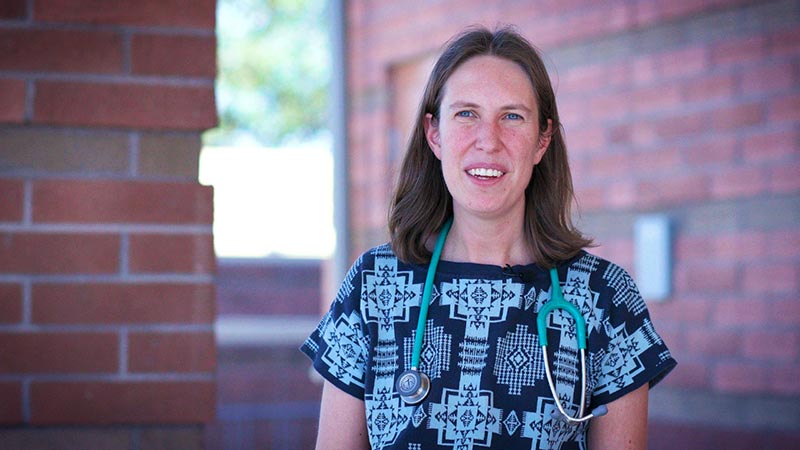Doctors at the Gallup Indian Medical Center learn best-practice care for dermatology, rheumatology and hepatitis C.
Access to timely care in New Mexico remains a challenge, especially in rural and underserved areas. Project ECHO is addressing this gap by connecting primary care providers with specialists through virtual telementoring, helping patients receive the right care at the right time, no matter where they live.
By reducing the need for long-distance travel and accelerating diagnosis and treatment, the ECHO Model empowers local providers to deliver best-practice care directly within their communities.
“Hágooshį́į́,” Alithea Gabrellas, MD, says to her patient in their native Dine language: “See you again someday.”
Gabrellas is an infectious disease doctor at the Gallup Indian Medical Center on the border of the Navajo Nation in Gallup, N.M. Operated by the Indian Health Service, GIMC is a 99-bed facility, with more than 250,000 outpatient visits and 5,800 inpatient admissions annually.
It’s the closest health care facility for many Navajo Nation residents. Many patients struggle to find and afford transportation to get there, and they may face a one- to two- hour drive, often on rough, unpaved roads.
When they’re finally able to see a doctor, imagine their disappointment when being referred to a specialist based in Albuquerque, 138 miles away, or Flagstaff, Ariz., a 185-mile journey.
“We have a huge problem with distance and delays in care,” says Daniel Mays, MD, primary care physician at GIMC. “Some people don’t get access to the health care they need just because of where they live. People who live in rural areas are often sicker because they’re not getting the care that they need as soon as they need it.”
Timely Care in New Mexico Expands Through Project ECHO
In 2013, Gabrellas was primary care doctor in Fort Defiance, N.M., a small community on the Navajo Nation, when she heard of Project ECHO, a telementoring organization dedicated to sharing knowledge in rural and under-resourced areas. Through ECHO’s hepatitis C program, she quickly learned how to administer a brand-new, gold-standard class of drugs
Project ECHO is a virtual learning community inspired by the way clinicians learn from medical rounds during residencies. During an ECHO session, participants present real, anonymized cases to specialists—and to each other—for discussion and recommendations. Primary care physicians can learn best practices in diabetes, cancer, HIV, and other disease areas, so their patients receive timely care where they live.

“With the knowledge I had from ECHO, I was able to help dozens of patients that first year,” Gabrellas said. “Many had suffered with hepatitis C for years but were not able to access treatment.” One of her patients was able to avoid a liver transplant because her health improved drastically once her hepatitis C was treated.
Bridging Health Care Gaps for Rural Communities
For Mays, ECHO gave him the confidence to prescribe complicated medications for rheumatoid arthritis that require intensive testing and monitoring. His patients benefited. Instead of months of waiting to see a specialist in a distant city, they could receive treatment in Gallup.
“Project ECHO is the way for rural health care providers to gain practical skills and knowledge that can be applied to the patients they’re going to see tomorrow,” Mays says.
“[ECHO] allows us to deliver a higher quality of care to patients and deliver services that those patients might not be able to get otherwise. That’s huge – that can save lives.”
About Project ECHO
Since 2003, Project ECHO’s telementoring model has been used to tackle the world’s greatest challenges in health care, education and more. Headquartered at The University of New Mexico Health Sciences Center in Albuquerque, Project ECHO is empowering local communities to improve the well-being of people around the world. Join us today, in our mission to touch 1 billion lives by 2025.
Featured image description: Panoramic view of rural New Mexico, representing underserved regions benefiting from improved access to care.


